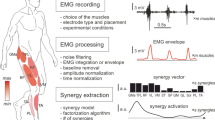Abstract
There is currently much interest in the synchronisation of neural discharge and the potential role it may play in information coding within the nervous system. We describe some recent results from investigations of synchronisation within the motor system. Local field potentials (LFPs) and identified pyramidal tract neurones (PTNs) were recorded from the primary motor cortex of monkeys trained to perform a precision grip task. The LFPs showed bursts of oscillatory activity at 20–30 Hz, which were coherent with the rectified electromyographs (EMG) of contralateral hand and forearm muscles. This oscillatory synchronisation showed a highly specific task dependence, being present only during the part of the task when the animal maintained a steady grip and not during the movement phases before or after it. PTNs were phase-locked to LFP oscillations, implying that at least part of the coherence between cortical activity and EMG was mediated by corticospinal fibres. The phase locking of the PTNs to LFP oscillations produced task-dependent oscillatory synchronisation between PTN pairs, as assessed by the single-unit cross-correlation histogram. Recordings were also made from normal human subjects performing a precision grip similar to that used in the monkey recordings. Pairs of EMGs recorded from intrinsic hand and forearm muscles showed 20–30 Hz coherence, which modulated during task performance, being present only during periods of steady contraction. We suggest that these changes in EMG-EMG synchronisation reflect changing levels of synchronous drive from the corticospinal system. The generation of oscillations in the cortex is discussed in the light of results from a model of local cortical circuits. Other modelling work has shown that synchrony in the corticospinal inputs could act to recruit motoneurones more efficiently, producing more output force from a muscle than asynchronous inputs firing at the same mean rate. A speculative hypothesis is presented on the role of synchronous oscillations in the motor system, which is consistent with experimental observations to date.
Similar content being viewed by others
Author information
Authors and Affiliations
Additional information
Received: 17 July 1998 / Accepted: 10 December 1998
Rights and permissions
About this article
Cite this article
Baker, S., Kilner, J., Pinches, E. et al. The role of synchrony and oscillations in the motor output. Exp Brain Res 128, 109–117 (1999). https://doi.org/10.1007/s002210050825
Issue Date:
DOI: https://doi.org/10.1007/s002210050825




